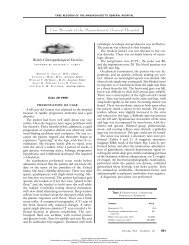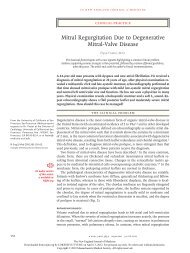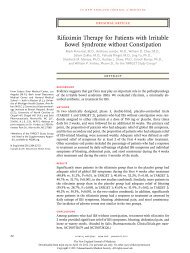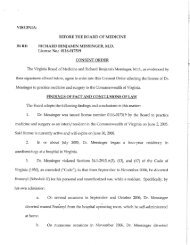The Leading Diagnosis
The Leading Diagnosis
The Leading Diagnosis
Create successful ePaper yourself
Turn your PDF publications into a flip-book with our unique Google optimized e-Paper software.
2390<br />
derlying hematologic disorder (such as sickle cell<br />
disease, thalassemia, or glycerophosphoryl diester<br />
phosphodiesterase deficiency, all of which are<br />
more common in blacks) might also underlie her<br />
previously diagnosed anemia. Other less common<br />
causes of small-intestinal bleeding and pain include<br />
tumors, mesenteric ischemia, Meckel’s diverticulum<br />
(although the pain is typically less severe),<br />
and endometrial deposits along the intestinal tract<br />
with pain that may correlate with the periodicity<br />
of the menses.<br />
On examination, the patient was afebrile, with a<br />
heart rate of 100 beats per minute, a respiratory<br />
rate of 16 breaths per minute, an oxygen saturation<br />
of 100% while she was breathing ambient<br />
air, and a blood pressure of 115/65 mm Hg. Her<br />
height was 65 in. (165.1 cm), and she weighed<br />
115 lb (52.3 kg). She was restless on the gurney,<br />
clutching her abdomen. Her sclerae were anicteric,<br />
and her conjunctivae were pale. <strong>The</strong> oropharynx<br />
was normal, and the neck was supple, without<br />
lymphadenopathy. <strong>The</strong> heart sounds were<br />
regular, and the lungs clear. <strong>The</strong>re was no chestwall<br />
or flank tenderness. Abdominal examination<br />
revealed hyperactive bowel sounds and diffuse<br />
tenderness on palpation without rebound<br />
tenderness, organomegaly, or masses. <strong>The</strong> rectal<br />
examination showed no masses. A stool sample<br />
was brown and was negative for occult blood.<br />
<strong>The</strong> pelvic examination revealed no masses, cervical<br />
motion, or adnexal tenderness. <strong>The</strong>re was no<br />
edema in the legs. <strong>The</strong> neurologic examination<br />
was normal.<br />
<strong>The</strong> observations that the patient is restless (as<br />
compared with the still appearance that would be<br />
expected in diffuse peritonitis), that she is clutching<br />
her abdomen but not avoiding touch, and that<br />
she has hyperactive bowel sounds and no rebound<br />
tenderness argue against generalized peritonitis,<br />
although these findings do not rule out early peritoneal<br />
inflammation. On this occasion, there is<br />
no occult blood in her stool, but conjunctival pallor<br />
suggests profound anemia. Given her history,<br />
I continue to be concerned about gastrointestinal<br />
blood loss, and I wonder in particular about inflammatory<br />
bowel disease as the cause of her condition.<br />
Admission to the hospital is warranted to determine<br />
the cause of her severe pain. A negative<br />
serum human chorionic gonadotropin (hCG) test<br />
would rule out ectopic pregnancy. If routine labo-<br />
T h e n e w e ng l a nd j o u r na l o f m e dic i n e<br />
n engl j med 357;23 www.nejm.org december 6, 2007<br />
ratory tests do not point to the source of pain,<br />
urgent abdominal imaging with computed tomography<br />
(CT) is indicated. CT is more sensitive than<br />
plain radiography for detecting the presence and<br />
source of intraabdominal free air, and it may reveal<br />
small-bowel obstruction or bowel-wall thickening.<br />
This latter result, although nonspecific,<br />
would be compatible with bowel-wall edema due<br />
to ischemia, infection, inflammation, or neoplastic<br />
infiltration. Given my low suspicion for infection,<br />
this finding might lead to endoscopic evaluation<br />
of the bowel.<br />
<strong>The</strong> serum sodium, potassium, and calcium levels<br />
were normal. <strong>The</strong> blood urea nitrogen level<br />
was 9 mg per deciliter (3.2 mmol per liter), creatinine<br />
0.6 mg per deciliter (53 μmol per liter), lipase<br />
22 U per liter (normal range, 1 to 60), aspartate<br />
aminotransferase 25 U per liter (normal<br />
range, 8 to 31), alanine aminotransferase 10 U<br />
per liter (normal range, 7 to 31), alkaline phosphatase<br />
55 U per liter (normal range, 39 to 117),<br />
and total bilirubin 0.3 mg per deciliter (5.1 μmol<br />
per liter) (normal range, 0.1 to 1.2 mg per deciliter<br />
[2 to 21 μmol per liter]). <strong>The</strong> white-cell count<br />
was 6400 per cubic millimeter, with 87% neutrophils,<br />
9% lymphocytes, and 4% monocytes. <strong>The</strong><br />
hematocrit was 23%, with a mean corpuscular<br />
volume of 65 μm 3 . A peripheral-blood smear<br />
showed 2+ microcytosis, 2+ hypochromia, and<br />
no other abnormal cells. A serum test for hCG<br />
was negative. Dipstick testing of a specimen of<br />
voided urine revealed a specific gravity of 1.022<br />
and a pH of 5.0; tests for protein, leukocyte esterase,<br />
nitrites, and blood were negative. Urine<br />
microscopical examination showed no white or<br />
red cells.<br />
<strong>The</strong>se results rule out ectopic pregnancy. Pyelonephritis<br />
would be unlikely without pyuria, and, although<br />
no amylase level was reported, the normal<br />
lipase level argues against pancreatitis. Advanced<br />
cholecystitis and cholangitis are unlikely given the<br />
normal results of the liver-function tests. A normal<br />
white-cell count soon after the onset of symptoms<br />
does not rule out bowel obstruction or inflammatory<br />
processes such as appendicitis. <strong>The</strong><br />
most salient findings are the low hematocrit and<br />
mean corpuscular volume. Iron deficiency and<br />
thalassemia are the most common causes of these<br />
values. In this patient with metromenorrhagia and<br />
bleeding from the rectum, iron deficiency is a more<br />
likely cause. Although her menorrhagia could ac-<br />
<strong>The</strong> New England Journal of Medicine<br />
Downloaded from nejm.org by LOKESH VUYYURU on May 18, 2012. For personal use only. No other uses without permission.<br />
Copyright © 2007 Massachusetts Medical Society. All rights reserved.







